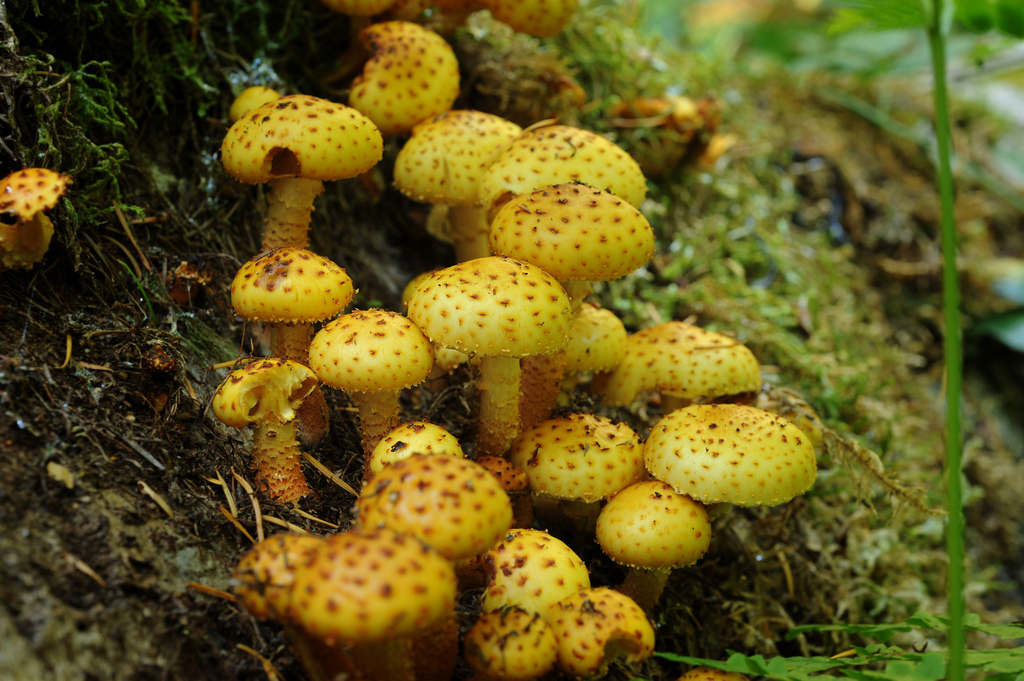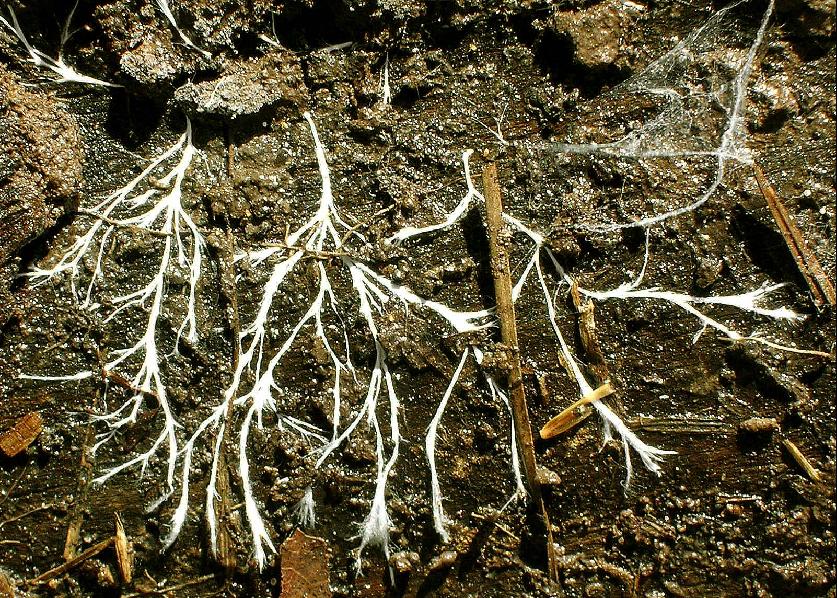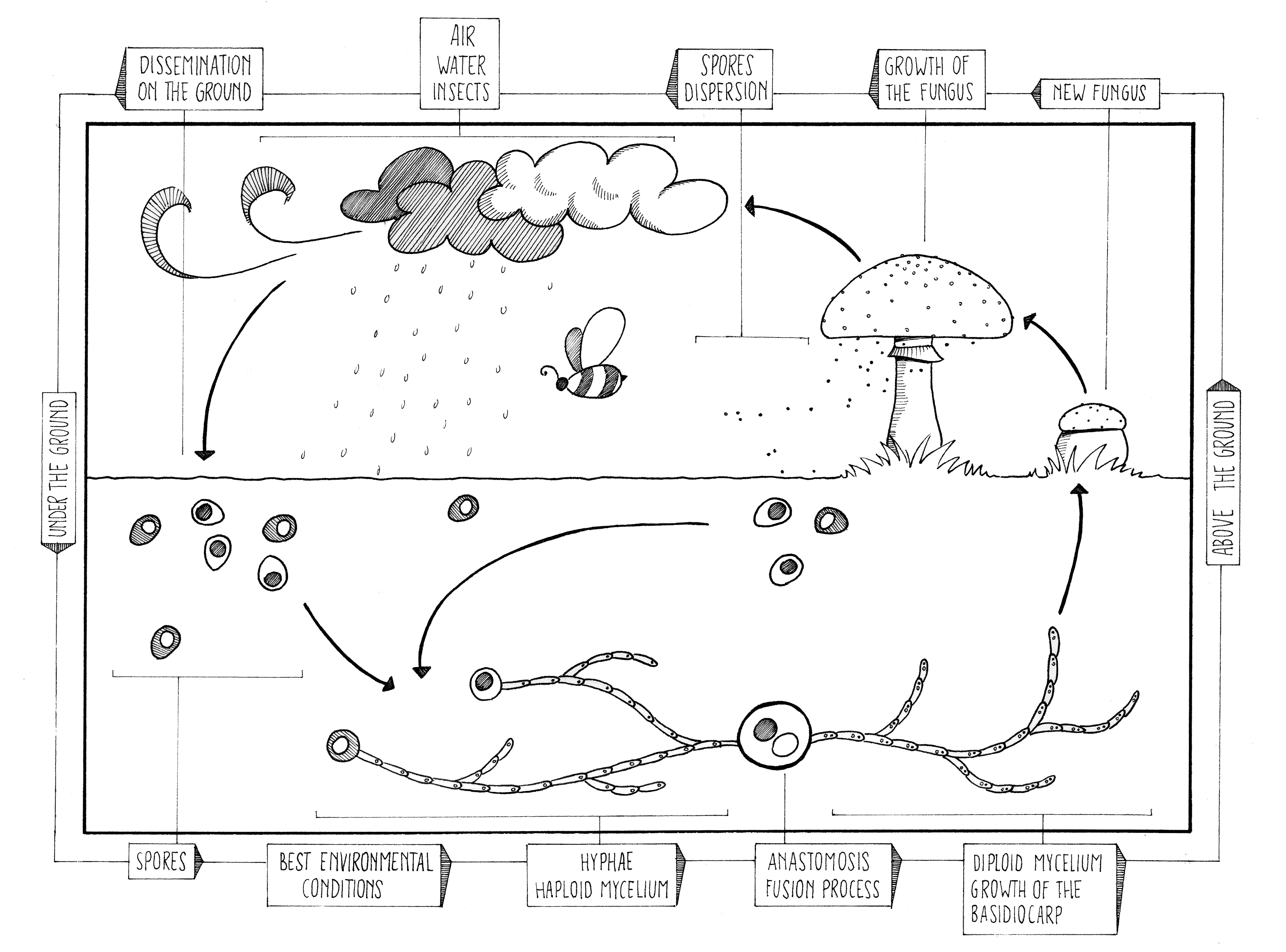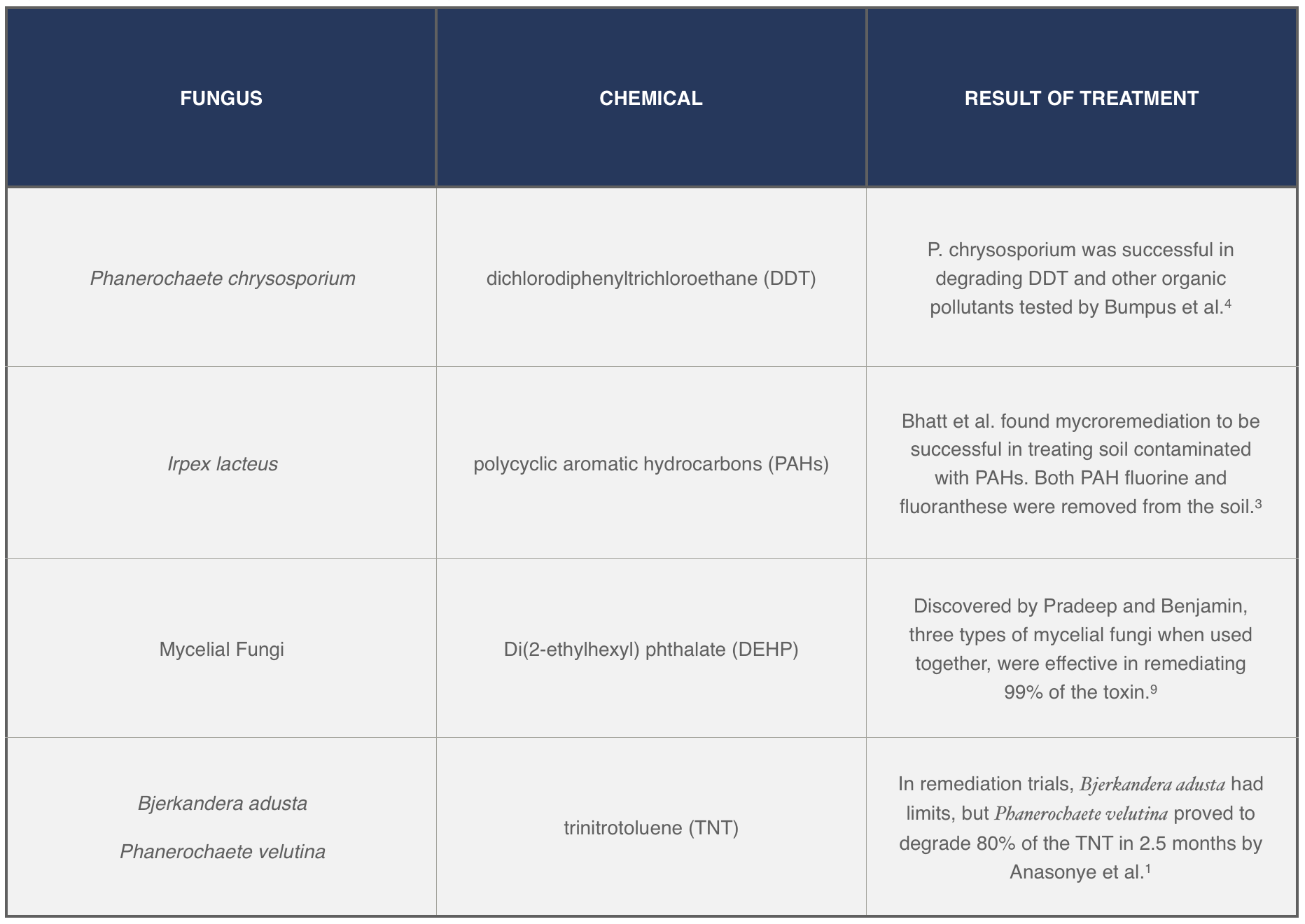Pollution
3.6 Mycoremediation: Studies in Mycelium as an Agent of Bioremediation
Nathan M. Watson
Methods to reverse contamination and clean up pollution are often expensive and inefficient. Can pollutants be remediated in a practical, efficient, cost-effective and eco-friendly way using fungi? Is bioremediation the future of ecosystem restoration?

In the 2005 book Mycelium Running by Paul Stamets, the author proposes ways in which “mushrooms can help save the world.”10 Mycelium is the vegetative heart of fungus. It creates a network in soils for nutrient exchange among plants. A fungi life cycle includes many stages, including hyphae that extend underground. These tubular structures are responsive, hearty, diverse, ancient, and very complex in their behavior. Stamets believes, “that mycelium is the neurological network of nature.”10
Although often a membrane only one cell thick, the world’s largest organism is a mycelial mat in Oregon’s Blue Mountains that encompasses an area of nearly four square miles, and could be up to 8,650 years old.5 Fungus serves as nature’s recycling agent. It typically secretes digestive enzymes into its environment that break down molecules for use as a food source.5 This process is the central concept to one of the ways that Stamets suggests mushrooms can help save the world: mycoremediation.10
Mycoremediation is the process of bioremediation using mycelium.3 Bioremediation is defined as the method of “cleaning up contamination in the environment through the activities of living organisms.”13 One category of bioremediation is bioaugmentation, which involves introducing organisms that can degrade contaminants.13 Mycelium has been degrading molecules for hundreds of millions of years, so employing it for bioaugmentation is a natural fit.

Pollution is an unfortunate consequence of the technological advances made by mankind, and the methods to reverse contamination are often expensive and inefficient. The earliest well-known use of fungi in bioaugmentation came in 1985, when J.A. Bumpus and his team used a fungus called Phanerochaete chrysosporium to degrade dichlorodiphenyltrichloroethane (DDT), a popular pesticide that proved to be harmful to several aspects of the environment.4 Bumpus and his team also showed that P. chrysosporium degraded other organic pollutants.4 The use of DDT has been banned for many years, but other pollutants are more ubiquitous than ever.
The compounds known as polycyclic aromatic hydrocarbons (PAHs) are fairly common compounds that are largely produced when organic matter is burned.8 Some are harmless, but the National Toxicology Program lists fifteen of them as “reasonably anticipated to be human carcinogens.”8 A 2002 study of two PAH-contaminated soils used two types of white rot fungal cultures to degrade twelve PAHs, and examined the effects that mycoremediation had on the toxicity of the soils.3 Seed germination tests were also performed before and after the mycoremediation.3 Results showed that germination rates for mustard seeds were related to soil contaminant concentrations, with higher concentrations being more limiting to growth.3 After fourteen weeks of incubation, the fungus Irpex lacteus removed 67% of the PAH fluorine, and 57% of fluoranthene among others.3 Not all of the PAHs being examined were degraded, but the results suggest that mycoremediation is effective in treating PAH-contaminated soil.3
Mycoremediation of PAH contaminated soil is more complex when practiced in situ. When mobilizing agents are introduced in a laboratory setting, the ability of mycelium to degrade compounds can be less effective.7 This is the result of lower availability of the PAH in the soil.7 Another approach to in situ contaminated soil occurred in 2007 on a condemned industrial site in Italy.2 Heavy metals were first leached out with citric acid, and then the soil was treated with fungal mycelium of the genus Allescheriella to degrade the remaining organic pollutants.2 This in situ study resulted in the remediation of 63.8% of organic pollutants.2 Integrated techniques such as this could prove most useful when contaminants are less available for remediation.2

Some pollutants are more subtle than pesticides and byproducts of combustion. Di(2-ethylhexyl) phthalate (DEHP) is a common additive to increase strength and flexibility in plastic medical devices, namely polyvinylchloride (PVC) blood storage bags.9,12 Because the DEHP is not chemically bonded to PVC, it washes away and ends up in watersheds when the plastics are buried.9 DEHP has been shown to be harmful to animals and humans, especially in early stages of development.9,12 In 2012, scientists in India showed that DEHP still bonded to PVC blood bags could be remediated with three types of mycelial fungi, either acting separately, but most effectively when used together.9 Over 99% of the toxin was remediated, leaving only PVC that could be recycled for future use.9 The mycoremediation used in this case was very efficient, cost-effective, and eco-friendly.9
Bioaugmentation has been studied for several years to combat another common, more obvious pollutant: trinitrotoluene, or TNT.6 In 1999, the fungus Bjerkandera adusta was shown to degrade TNT, but the in situ applications had limits.6 For a fungus to effectively degrade TNT in soil in situ, it must also be able to tolerate indigenous organisms.1 A 2015 study used three types of fungi to treat soil contaminated with TNT from previous explosive operations.1 Phanerochaete velutina was found to be most effective and thought to have large scale practical use in situ.1 This fungus degraded 80% of the TNT in only 2.5 months.1 Mycoremediation has provided yet another example of pollutant treatment that is superior to the current method as recently as November, 2015.1

Paul Stamets has devoted his life to fungus. He currently holds eight patents related to mycelium, ranging from medicinal mushrooms that have antiviral and antibacterial properties, to mycelium as a pesticide.11 While working with Battelle Labs in 1998, he took part in an experiment that involved treating soil that had been contaminated with diesel and oil.10 Stamets and his team were given four piles of soil, contaminated at 20,000 parts per million (ppm) petroleum hydrocarbons.10 One pile was the untreated control, one was treated with enzymes, one with bacteria, and the last with the mycelium of the familiar oyster mushroom.10 After four weeks, three of the piles were still black and lifeless, while the mycelium treated pile had become overtaken with oyster mushrooms (Figure 5).10
Over the next few weeks, the mushrooms produced spores and died. In doing so, they attracted insects, which laid eggs that became larvae.10 This attracted birds that carried seeds and more nutrients.10 After 9 weeks, the previously contaminated soil had become full of plant and animal life, while the other piles still remained mostly unchanged.10 The final concentration of petroleum hydrocarbons for the mycelium treated pile was less than 200 ppm.10 This example shows the remarkable effects of mycoremediation.10
References:
- Anasonye, F., et al. (2015). Bioremediation of TNT contaminated soil with fungi under laboratory and pilot scale conditions. International Biodeterioration and Biodegradation, 105:7-12.
- Baldi, F., et al. (2007). Integrated approach of metal removal and bioprecipitation followed by fungal degradation of organic pollutants from contaminated soils. European Journal of Soil Biology, 43(5-6):380-387.
- Bhatt, M., et al. (2002). Mycoremediation of PAH-Contaminated Soil. Folia Microbiologica, 47(3):255-258.
- Bumpus, J., et al. (1985). Oxidation of Persistent Environmental Pollutants by a White Fungus Rot. Science, 228(4706):1434-1436.
- Casselman, A. (2007, October 4). Strange but True: The Largest Organism on Earth Is a Fungus. Scientific American. Retrieved from https://www.scientificamerican.com/article/strange-but-true-largest-organism-is-fungus/
- Eilers, A., et al. (1999). Metabolism of 2,4,6-trinitrotoluene by the white-rot fungus Bjerkandera adusta DSM 3375 depends on cytochrome P-450. Applied Microbiology and Biotechnology, 53(1):75-80.
- Leonardi, V., et al. (2007). Bioavailability modification and fungal biodegradation of PAHs in aged industrial soils. International Biodeterioration and Biodegradation, 60(3):165-170.
- National Toxicology Program. (No date). Polycyclic Aromatic Hydrocarbons: 15 Listings. Retrieved from http://ntp.niehs.nih.gov/ntp/roc/content/profiles/polycyclicaromatichydrocarbons.pdf
- Pradeep, S. & Benjamin, S. (2012). Mycelial fungi completely remediate di(2-ethylhexyl)phthalate, the hazardous plasticizer in PVC blood storage bag. Journal of Hazardous Material, 235-236:69-77.
- Stamets, P. (2005). Mycelium Running: How Mushrooms Can Help Save the World. Berkeley, CA: Ten Speed Press.
- Stamets, P.E. (2009, May). Antiviral and antibacterial activity from medicinal mushrooms. U.S. Patent 8,765,138.
- Tickner, J., et al. (2001). Health risks posed by use of Di-2-ethylhexyl phthalate (DEHP) in PVC medical devices: A critical review. American Journal of Industrial Medicine, 39(1):100-111.
- U.S. Geological Survey. (2013, January 13). Bioremediation.
Figures:
- furtwangl. (2009). [Photograph of Pholiota aurivella mushrooms]. Retrieved from FlickrCommons. CC BY 2.0.
- Righetto, Anna, DensityDesign Research Lab. (2014). [Diagram of sexual reproduction cycle in basidiomycetes]. Retrieved from Wikimedia Commons. CC BY-SA 4.0.
- TheAlphaWolf. (2006). [Photograph of hyphae under an overturned log]. Retrieved from Wikimedia Commons. CC BY-SA 3.0.
